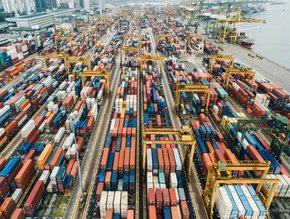Key Insights: GEP Global Volatility Index March 2024

The monthly GEP survey is a guide for procurement, purchasing and supply chain professionals around the world about the ongoing conditions, shortages, transportation costs, inventories and backlogs based on a monthly survey of 27,000 businesses. The latest data considered in the March 2024 report indicates that suppliers around the world are now very close to full utilisation and after nearly a year of declining supplier activity, capacity pressures have begun building again.

“Globally in February, we saw supply chains being more utilised, suppliers are busier, and input demand and manufacturing are turning a corner after nearly a year of low-capacity utilisation,” explained Mukund Acharya, Vice President, Consulting, GEP. “Suppliers to North America were the busiest globally last month, spurred by the Inflation Reduction Act and Bipartisan Infrastructure Law driving economic activity in construction, semiconductors, and renewables.”

Three key insights from GEP Global Supply Chain Volatility Index
- Input demand is beginning to recover across all major markets, after a protracted nearly two-year period of decline. Signalling recovery in manufacturing.
- North American suppliers see capacity stretched for the first time in nearly a year as manufacturers, especially in consumer-facing sectors, report growth
- Global transportation costs fall despite Red Sea disruptions
While global supplier capacity is still underutilised, the index increased to -0.08, from -0.12 in January, its highest in 10 months. After nearly a year of declining supplier activity, capacity pressures have begun building again.
Global demand for raw materials, commodities and components also showed signs of recovery in February after a nearly two-year period of decline due to destocking and high inflation. Input demand was stable in Asia, signalling restocking and economic resilience across the region. Similarly, evidence of inventory building in North America suggests the continent’s manufacturers are preparing for growth. In fact, capacity at suppliers to North America was stretched for the first time since March 2023, with backlogs ticking higher as a consequence.
The index also suggests the Red Sea attacks have had a negligible impact on global supply chains. The most visible effect was an uptick in transportation costs in January, but global logistics costs fell during February.

Key Findings GEP Global Supply Chain Volatility Index
DEMAND: Although global demand for raw materials, commodities and components was still weak by historical standards, the downturn cooled, with trends improving across all major markets.
INVENTORIES: After reaching a seven-month high in January as the Suez Canal disruption led to an increase in safety stockpiling, reports of firms building inventory buffers to protect against shortages or price changes fell in February.
MATERIAL SHORTAGES: Reports of item shortages remained among the lowest seen in four years.
LABOUR SHORTAGES: There was some further upward movement seen in the frequency at which global manufacturers were reporting shortages of staff. Albeit the highest in six months, reports of poor labour availability remained only just above historically typical levels.
TRANSPORTATION: Global transportation costs decreased in February, indicating a reduced impact on global supply chains from the disruption to shipping through the Suez Canal.
Regional variations in the GEP Global Supply Chain Volatility Index
NORTH AMERICA: Index rose to 0.17, from -0.33, its highest since January 2023, showing stretched supplier capacity as manufacturers are boosting inventories and preparing for near-term production growth.
EUROPE: Index rose sharply again to -0.41, from -0.63. While this is a sizable improvement, the continent is still experiencing economic stress. Factory purchasing activity in Europe remained depressed amid the ongoing recession in Germany’s manufacturing industry, but recoveries in southern Europe supported the index’s move higher.
U.K.: Index hits 10-month high of -0.34, up from -0.62 previously. U.K. companies report a marked uplift in safety stockpiling activity due to Red Sea disruptions.
ASIA: Index stabilises at -0.02, falling slightly from 0.14 in January as sharp manufacturer purchasing growth in India is offset by weaker demand in Japan, Vietnam and Taiwan.
How does the GEP Global Supply Chain Volatility Index work?
The GEP Global Supply Chain Volatility Index is produced by S&P Global and GEP. It is derived from S&P Global’s PMI surveys and sent to 27,000 global companies. The headline figure is a weighted sum of six sub-indices derived from PMI data, PMI Comments Trackers and PMI Commodity Price & Supply Indicators compiled by S&P Global.
What do the values in the GEP Global Supply Chain Volatility Index mean?
A value above 0 indicates that supply chain capacity is being stretched and supply chain volatility is increasing. The further above 0, the greater the extent to which capacity is being stretched.
A value below 0 indicates that supply chain capacity is being underutilised, reducing supply chain volatility. The further below 0, the greater the extent to which capacity is being underutilised.
The index is published once a month and you can review the February survey here.
Make sure you check out the latest edition of Procurement Magazine and also sign up to our global conference series - Procurement & Supply Chain LIVE 2024
**************
Procurement Magazine is a BizClik brand






